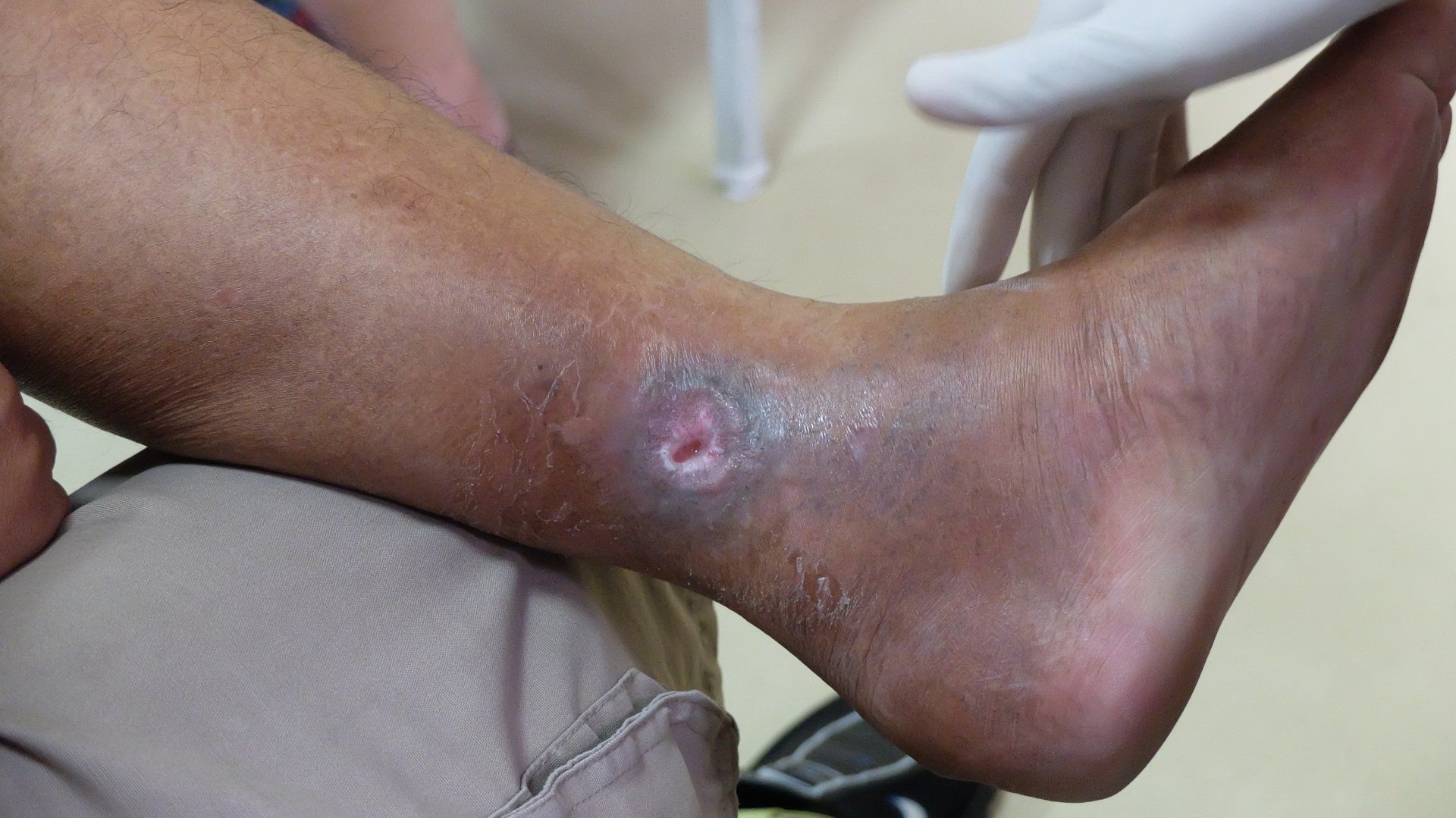Venous Stasis Ulcers

Venous Stasis Ulcers are sores that usually occur around the ankle or lower leg and are usually associated with long term vein problems (think blood clots (DVT), phlebitis (SVT), leg swelling, varicose or spider veins, etc). They are the most common ulcers that occur in the legs and up to 1-3% of adults will develop this type of ulcer in their lifetime. They can take weeks or months to heal, but usually do not result in amputation like diabetic foot ulcers or arterial ulcers.
Symptoms of Venous Disease that may lead to a Venous Stasis Ulcer
- Leg swelling, heaviness, and aching in the leg or calf, worst at night after being up on your feet all day.
- Spider or varicose veins in the leg or calf.
- Itching (pruritis) in the leg or calf.
- Bluish skin discoloration from blood pooling in the lower leg. Skin may turn a bronze color (hyperpigmentation) and feel tough or scarred with long term inflammation.
- Once an ulcer occurs, it is usually around the ankle area, more commonly on the inside ankle.
- The ulcer can be painful, irregularly shaped, with shiny skin around the ulcer. Drainage from the ulcer is common.
Risk factors for Venous Stasis Ulcers
- Advanced age (4% of patients older than 65 will develop a venous stasis ulcer.
- Women have a higher risk of forming venous stasis ulcers (related to hormones, multiple pregnancies).
- Family history of varicose veins.
- Obesity
- History of leg trauma or multiple leg surgeries.
- History of deep vein thrombosis (DVT) or superficial vein/varicose vein clots (SVT, phlebitis).
- Occupation where prolonged standing or sitting is required.
Diagnosis of Venous Stasis Ulcers
- A good history, asking about the previously discussed symptoms and risk factors.
- Physical exam would reveal a sore/ulcer, usually on the inside of the ankle area
- Physical exam might also show signs of long standing venous stasis disease (leg swelling, skin discoloration, varicose veins, and spider veins).
- A venous insufficiency ultrasound/duplex may be ordered to check for deep vein thrombosis or phlebitis, varicose veins, and to check for abnormal vein function causing blood to pool in the lower legs.
- ABIs or arterial ultrasound/duplex may be ordered if there is suspicion of peripheral arterial disease (PAD). This will ensure there is adequate arterial flow to heal the ulcer. Combined arterial insufficiency and venous insufficiency makes it much harder to heal a venous stasis ulcer.
Treatment of Venous Stasis Ulcers
- Graded Compression Stockings
Used to prevent ulcers or healed ulcers from recurring. The compression stockings help decrease the pressure in the veins by forcing blood into the deeper veins which are surrounded by muscles that help pump the venous blood from the foot back to the heart. Stockings also helps the blood back up the leg instead of pooling and leaking of fluid and inflammatory proteins into the tissue under the skin.
- Unna Boot
A zinc medicated gauze wrap followed by a compression wrap applied around the lower leg, from the base of the toes to just below the knee. This dressing is usually left on for several days and is very effective at healing an ulcer. Medications like aspirin, blood thinners, antibiotics if infection sets in, or other specific medications may be prescribed.
- Minimally invasive vein procedures may help the wound heal faster. Endovenous ablation of the greater or lesser saphenous veins. This procedure is performed in the office with valium sedation and lidocaine (see Varicose vein procedures). It closes the abnormal vein that is causing pooling and high pressure in the tissues around the venous stasis ulcer. Endovenous iliac vein stents. This procedure can also be performed in the office with moderate intravenous sedation. It is performed if there is narrowing or blockage in the pelvic veins that impede the normal blood flow from the feet back to the heart, causing the blood to back up resulting in high pressure in the leg veins.
- Surgery in the operating room may be required if the ulcer is severe with dead tissue surrounding the ulcer.
Once diagnosed with a Venous Stasis Ulcer, it is best to have a team of health care providers including your primary care physician to help control your medical problems and medications, a vascular surgeon to help diagnose and treat the ulcers, with either minimally invasive techniques or surgery performed in the operating room at the hospital, and possibly even an infectious disease specialist if infection is present. Most importantly, a good wound care center with certified wound care nursing staff will help heal the wound as fast as possible.


